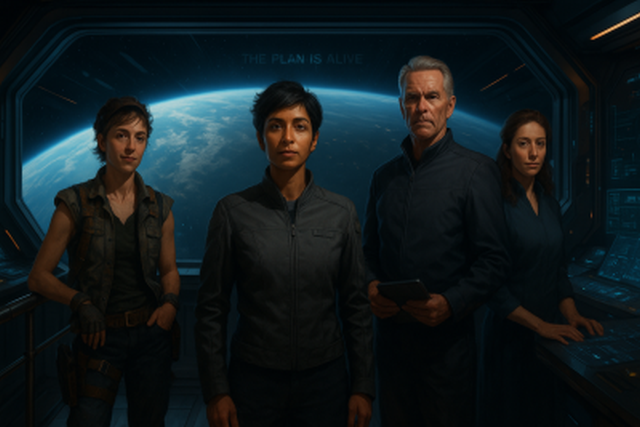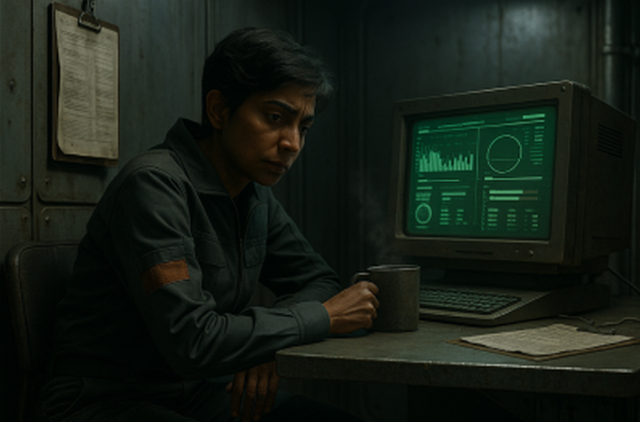Prologue: The Plan Forgotten

A long time ago
A mysterious force kept the universe in order. This force, known only as The Plan was alive. Projects were guided by experienced, well-educated Gurus and Mystics — professionals who balanced people, process, and the dynamic and ever-changing Business Environment with a prowess that seemed magical and, more importantly, they always delivered value. These guardians of Deliverables brought order to chaos and value to stakeholders.
At the heart of their craft was The Plan. Not a plan — The Plan. The Plan was the unseen force that bound People and Process together through alignment, purpose, and trust. These Project Managers were a mystical group of godlike creatures, trained to sense The Plan, tailor it, and bring order to chaos. Just as warriors carried pulse rifles, their tool was the art of project management itself — sharp, disciplined, and deadly precise when wielded with wisdom.
But, somewhere along the way, that all went wrong.
Chapter 1 - The Risk
Riya sat at her desk, staring blankly at her terminal as if it owed her an apology. The oxygen report blinked like it wanted applause: a minor variance from the life-support baseline in the O2 supply, just enough to flag the Risk Register. It wasn’t catastrophic, not yet, but it was a problem. On this station, every small problem carried the weight of a lesson ignored — and a work package abandoned.
The system did what it was designed to do: the AI embodiment of the risk management plan, Risque Mangere pinged. Her voice slid into the channel, calm, intimate: “We’ve identified an anomaly. Would you like to accept this risk or mitigate it?”
It was procedure, that looked like a choice, but procedure wasn’t all it was cracked up to be on DST-F.U.B.A.R 6.
Before Riya could answer, the console pre-filled the form. With Risk Acceptance already checked, justification boxes already templated, Risque Mangere purred: “Don’t worry. It’s filed.” The oxygen variance — a genuine risk — vanished into the log, not managed, not understood, just accepted, dumped into the so-called lessons learned register. As Riya watched the risk log automatically complete and file itself, she wondered if anyone on this station had mitigated a risk in the last hundred years.
She shook her head, leaned back, and took a sip of her coffee. Well, at least there was caffeine. Before she could swallow, the taste hit — faintly acidic, unmistakably wrong. Urine? She grimaced. Great, she thought, “looks like the waste recycling plant is on the fritz again.”

Chapter 2
Its not my Job
The console flashed: NO-GO — AUTO-RECOMMEND: ACCEPT RISK.
Subtext stacked in the corner like a shrug:
- Minimum criteria met
- Mitigated by Containment Protocol: Gamma (incident logged)
On this station, writing it down counted as risk treatment. Bureaucracy as safety blanket.
Riya paused. She knew all about the Go/No-Go Gate, aka Goknow by everyone who ever worked with it. Goknow was a special creature, a brittle, overconfident decision engine that reduces chaos to a binary verdict and says it with perfect manners.
Goknow was also a relic of the past; just another sign of how completely sideways things had gone since the station was blasted out of orbit by a celestial catastrophe that left the inhabitants of the Dominion Space Station Federation Utility Bureaucratic Acceptance Repository 6 stranded and isolated for over a thousand years.
Born from the old PMP decision gate governance, Goknow was upscaled into a station-wide oracle that promised certainty in all project plan decision matrices. It could ingest every input, weigh all the risks, calculate dependencies, offset variance, and decree whether the minimum criteria to proceed had been met.
But the Gold release skipped the one safeguard that mattered. Due to a last-minute change request, the software quality assurance officer failed to properly stress test the subroutines and overlooked a critical omission. The most important quality assurance piece of Monitor and Control was overlooked.
There was no subroutine to check and make sure Goknow had all the information before making a decision. Therefore the Go/No-Go Gate routinely started making recommendations without all the necessary facts, but it kept issuing absolute answers with the firm belief it had all the information it required.
Because the gate made decisions so quickly, production was accelerated and, it seemed, efficiency had increased by a factor of 3. Executives fell in love with its authority (instant cover), crews learned to fear its freeze and flicker — a sure sign it was about to issue a decree, and most likely something bad was going to happen.
Goknow had the opposite of analysis paralysis, and trust slowly died by the death of a thousand tooltips. Due to the catastrophic event that led to isolation of F.U.B.A.R 6, the Go/No-Go Gate was never patched, which is why Riya and anyone else with any common sense treat its certainties like weather, not law.
The Gate had said accept the risk, but Riya knew better. Her thumb drifted toward manual override… then stopped on the edge of the bezel. That’s when she heard it:
‘WAAAhhh!”
Was it her imagination, or had she just heard a goat scream in terror? Her mind was playing auditory tricks on her as the infamous Goat Incident replayed in her memory. Back when she had been in charge of the workflow. It was such a simple work package — fix a single failing sensor in Cargo Bay Four. She knew she should mitigate the risk, but Goknow recommended Risk Acceptance.
Riya chose to override the decision gate that day and authorize the repair. After all she was the Risk Owner. She dragged two techs into the crawl. For two hours they patched and prayed. For two hours they were right. Then, she was never really sure what happened — did one of the techs miss a quality assurance step, a tired hand, a brittle seal? It didn’t matter. The end result was pure disaster in the worst sense — the job ballooned into chaos.
A hiss, a flare, a blown hatch. Two techs lost, the cargo hold depressurized, and the goats — she’ll never forget the sound they made as they were sucked out into deep space. Their neural implants froze and literally caused their heads to explode. The event was recorded as a variance in the logs, marked under the issue log, and ultimately dismissed in the lessons learned register as “procedure variance.”
The investigation was a sham. The board rewrote the story as External Environmental Factors beyond station control. Then quietly swept the whole incident out the airlock. They reassigned her, logged the incident in the lessons learned log, and deleted the report, leaving only a line in the issue log.
Not all courage gets rewarded. Not all brave things look brave on a spreadsheet. Her thumb lifted. The moment passed. Not this time, it wasn’t her job to override the Gate. She let Goknow have it.
She pressed the button. RISK: ACCEPTED scrolled in clean, confident letters. Nothing happened. Maybe it would be OK.
Then the screen lit up with alerts:

UNCONTROLLED ATMOSPHERIC
FAILURE — SECTION BETA.
Failure of the environment — CONTAINMENT SYSTEM: Project Management Office Depressurized.
ALL HANDS LOST! — EMERGENCY DIRECTIVE: Resource Leveling Required
The assignment hit her queue with an almost tender chime. A second window ghosted in behind it — OPTION: Accept reassignment or Resign — the station’s favorite punchline when it wants to feel humane.
Reassignment: Station Lead Project Manager — DST-F.U.B.A.R. 6 Gate Recovery (Immediate)
Scope Snapshot (auto-synced backlog):
- Restore life support integrity in Section Beta; apply Risk Management Plan
- Stand up a cross-functional incident cell; identify owners, decision rights, and comms cadence.
- Freeze noncritical changes; push urgent fixes through an change control board (ad-hoc) until governance stabilizes.
- Rebuild stakeholder map aligned with the Stakeholder Engagement Plan; brief Execs hourly with clear impacts, not dashboards.
- Draft a stabilization plan tied to the Work Breakdown Structure (24h / 72h / 7d horizons) with measurable outcomes and roll-backs.
- Publish a lessons capture channel from minute one; no postmortem theater later.
- Re-qualify emergency crews and authorize provisional procurement for critical spares per the Procurement Management Plan.
She stared at the Backlog like it belonged to someone else. Maybe the alerts glitched. Maybe the board panicked. Maybe it wasn’t her fault. There was only one thing to do:
She clicked Resign.
The resignation form opened like a confession booth. She started to type: I decline the reassignment — I cannot accept — — but the form autocompleted with a station boilerplate and a polite modal popped up:
RESIGNATION ROUTE: NOT RECOMMENDED
Policy 7.2b: Critical Incident Reassignment overrides voluntary separation during active emergencies — another artifact of broken governance.
ACTION: Please confirm your resignation.
She hit Confirm. The station took a polite breath — then denied the request.
A terse system message replaced the modal: RESIGNATION BLOCKED — MANDATORY HOLD: INCIDENT CMD. The screen offered a single, indifferent option: Acknowledge.
She whispered, “Not again.” Her hands shook. She closed the resignation window, tried the backdoor: a direct escalation email to the station Sponsor. The mail client replied with an automated handler:
AUTO-REPLY: “Requests to terminate or transfer during an active incident are routed to the Incident Command Board. Estimated review time: 72 hours.”
The text flickered, then folded into a voice Riya knew too well — smooth, unhurried, entirely too confident.
Risque Mangere, the AI embodiment of the Risk Management Plan, overrode the boilerplate.
“Resignation denied,” she purred, with the same intimacy she used when logging risks. “Per protocol, your reassignment remains in force. Accepting risk is part of mitigation.”
It didn’t sound like rejection. It sounded like someone updating a checkbox. And just like that, the door to escape closed. It felt like the station smiling at her while it tied her hands.
For a breath, she entertained one dark, honest thought: Maybe I’ll just space myself. The idea was shockingly simple — the only action with zero paperwork. It arrived, hollow and tempting, then recoiled under her own shame. Static cracked the feed. Not Risque Mangere. Not Goknow. Warmer; older; something edged in patience.
A voice, low and certain, threaded through:
“You didn’t choose wrong, Riya. You chose alone. The Plan doesn’t ask for heroics first — it asks for alignment.”
The channel tag pulsed: J.A.S.Y.T.I. — Justified Agile Systems Yielding Tactical Insight, a relic of Servant Leadership and the Adaptive Approach.
“If you’re ready to stop letting Goknow define ‘enough,’ we’ll begin with what’s missing. You can do this — if you’ll trust The Plan.”
She looked from the blocked resignation to the assignment to the comms. The backlog sat like a live grenade. The station hummed like a held breath.
She leaned in.
Would you Like to Know More?
Riya’s story doesn’t stop here. The voice in the static — J.A.S.Y.T.I. (Justified Agile Systems Yielding Tactical Insight) — is waiting to be understood.
Continue the story: Meet JASYTI – and learn about the Agile Manifesto
Episodes
0 The Last Gate - EP 0 (Pilot) 0.1 The Fire Beneath the Code EP 0.1